Abstract
The lysophosphatidic acid (LPA) receptor LPA1/Edg2 is the first identified LPA receptor. Although its wide tissue distribution and biological functions have been well studied, little is known about how LPA1 is transcriptionally regulated. In the current study, we showed that LPA1 is a physiological target of transforming growth factor beta (TGFβ)-mediated repression. In both normal and neoplastic cells, TGFβ inhibits LPA1 promoter activity, LPA1 mRNA expression and LPA1-dependent chemotaxis and tumor cell invasion. Knockdown of the TGFβ intracellular effector Smad3 or Smad4 with lentivirally transduced short hairpin RNA relieved these inhibitory effects of TGFβ. Interestingly, the LPA1 promoter contains two potential TGFβ inhibitory elements (TIEs), each consisting of a Smad-binding site and an adjacent E2F4/5 element, structurally similar to the TIE found on the promoter of the well-defined TGFβ target gene c-myc. Deletion and point mutation analyses indicate that the distal TIE located at 401 bp from the transcription initiation site, is required for TGFβ repression of the LPA1 promoter. A DNA pull-down assay showed that the −401 TIE was capable of binding Samd3 and E2F4 in TGFβ-treated cells. TGFβ-induced binding of the Smad complex to the native −401 TIE sequence of the LPA1 gene promoter was further verified by chromatin immunoprecipitation assays. We therefore identified a novel role of TGFβ in the control of LPA1 expression and LPA1-coupled biological functions, adding LPA1 to the list of TGFβ-repressed target genes.
This is a preview of subscription content, access via your institution
Access options
Subscribe to this journal
Receive 50 print issues and online access
$259.00 per year
only $5.18 per issue
Buy this article
- Purchase on Springer Link
- Instant access to full article PDF
Prices may be subject to local taxes which are calculated during checkout





Similar content being viewed by others
References
Panupinthu N, Lee HY, Mills GB . Lysophosphatidic acid production and action: critical new players in breast cancer initiation and progression. Br J Cancer 2010; 102: 941–946.
Sano T, Baker D, Virag T, Wada A, Yatomi Y, Kobayashi T et al. Multiple mechanisms linked to platelet activation result in lysophosphatidic acid and sphingosine 1-phosphate generation in blood. J Biol Chem 2002; 277: 21197–21206.
Choi JW, Herr DR, Noguchi K, Yung YC, Lee CW, Mutoh T et al. LPA receptors: subtypes and biological actions. Annu Rev Pharmacol Toxicol 2010; 50: 157–186.
Noguchi K, Ishii S, Shimizu T . Identification of p2y9/GPR23 as a novel G protein-coupled receptor for lysophosphatidic acid, structurally distant from the Edg family. J Biol Chem 2003; 278: 25600–25606.
Lee CW, Rivera R, Gardell S, Dubin AE, Chun J . GPR92 as a new G12/13- and Gq-coupled lysophosphatidic acid receptor that increases cAMP, LPA5. J Biol Chem 2006; 281: 23589–23597.
Pasternack SM, von Kugelgen I, Aboud KA, Lee YA, Ruschendorf F, Voss K et al. G protein-coupled receptor P2Y5 and its ligand LPA are involved in maintenance of human hair growth. Nat Genet 2008; 40: 329–334.
Contos JJ, Fukushima N, Weiner JA, Kaushal D, Chun J . Requirement for the lpA1 lysophosphatidic acid receptor gene in normal suckling behavior. Proc Natl Acad Sci USA 2000; 97: 13384–13389.
Inoue M, Rashid MH, Fujita R, Contos JJ, Chun J, Ueda H . Initiation of neuropathic pain requires lysophosphatidic acid receptor signaling. Nat Med 2004; 10: 712–718.
Pradere JP, Klein J, Gres S, Guigne C, Neau E, Valet P et al. LPA1 receptor activation promotes renal interstitial fibrosis. J Am Soc Nephrol 2007; 18: 3110–3118.
Tager AM, LaCamera P, Shea BS, Campanella GS, Selman M, Zhao Z et al. The lysophosphatidic acid receptor LPA1 links pulmonary fibrosis to lung injury by mediating fibroblast recruitment and vascular leak. Nat Med 2008; 14: 45–54.
Chen H, Wu X, Pan ZK, Huang S . Integrity of SOS1/EPS8/ABI1 tri-complex determines ovarian cancer metastasis. Cancer Res 2010; 70: 9979–9990.
Yu S, Murph MM, Lu Y, Liu S, Hall HS, Liu J et al. Lysophosphatidic acid receptors determine tumorigenicity and aggressiveness of ovarian cancer cells. J Natl Cancer Inst 2008; 100: 1630–1642.
Fang X, Schummer M, Mao M, Yu S, Tabassam FH, Swaby R et al. Lysophosphatidic acid is a bioactive mediator in ovarian cancer. Biochem Biophys Acta 2002; 1582: 257–264.
Lin S, Wang D, Iyer S, Ghaleb AM, Shim H, Yang VW et al. The absence of LPA2 attenuates tumor formation in an experimental model of colitis-associated cancer. Gastroenterology 2009; 136: 1711–1720.
Su LJ, Chang CW, Wu YC, Chen KC, Lin CJ, Liang SC et al. Selection of DDX5 as a novel internal control for Q-RT-PCR from microarray data using a block bootstrap re-sampling scheme. BMC Genomics 2007; 8: 140.
Radvanyi L, Singh-Sandhu D, Gallichan S, Lovitt C, Pedyczak A, Mallo G et al. The gene associated with trichorhinophalangeal syndrome in humans is overexpressed in breast cancer. Proc Natl Acad Sci USA 2005; 102: 11005–11010.
Hendrix ND, Wu R, Kuick R, Schwartz DR, Fearon ER, Cho KR . Fibroblast growth factor 9 has oncogenic activity and is a downstream target of Wnt signaling in ovarian endometrioid adenocarcinomas. Cancer Res 2006; 66: 1354–1362.
Sanchez-Carbayo M, Socci ND, Lozano J, Saint F, Cordon-Cardo C . Defining molecular profiles of poor outcome in patients with invasive bladder cancer using oligonucleotide microarrays. J Clin Oncol 2006; 24: 778–789.
Skrzypczak M, Goryca K, Rubel T, Paziewska A, Mikula M, Jarosz D et al. Modeling oncogenic signaling in colon tumors by multidirectional analyses of microarray data directed for maximization of analytical reliability. PLoS One 2010; 5: e13091.
Marshall JC, Collins J, Marino N, Steeg P . The Nm23-H1 metastasis suppressor as a translational target. Eur J Cancer 2010; 46: 1278–1282.
Horak CE, Mendoza A, Vega-Valle E, Albaugh M, Graff-Cherry C, McDermott WG et al. Nm23-H1 suppresses metastasis by inhibiting expression of the lysophosphatidic acid receptor EDG2. Cancer Res 2007; 67: 11751–11759.
Jeon ES, Moon HJ, Lee MJ, Song HY, Kim YM, Cho M et al. Cancer-derived lysophosphatidic acid stimulates differentiation of human mesenchymal stem cells to myofibroblast-like cells. Stem Cells 2008; 26: 789–797.
Xu MY, Porte J, Knox AJ, Weinreb PH, Maher TM, Violette SM et al. Lysophosphatidic acid induces alphavbeta6 integrin-mediated TGF-beta activation via the LPA2 receptor and the small G protein G alpha(q). Am J Pathol 2009; 174: 1264–1279.
Sauer B, Vogler R, Zimmermann K, Fujii M, Anzano MB, Schafer-Korting M et al. Lysophosphatidic acid interacts with transforming growth factor-beta signaling to mediate keratinocyte growth arrest and chemotaxis. J Invest Dermatol 2004; 123: 840–849.
Wu J, Mukherjee A, Lebman DA, Fang X . Lysophosphatidic acid-induced p21waf1 expression mediates the cytostatic response of breast and ovarian cancer cells to TGF beta. Mol Cancer Res 2011; 9: 1562–1570.
Markowitz S, Wang J, Myeroff L, Parsons R, Sun L, Lutterbaugh J et al. Inactivation of the type II TGF-beta receptor in colon cancer cells with microsatellite instability. Science 1995; 268: 1336–1338.
Shida D, Kitayama J, Yamaguchi H, Okaji Y, Tsuno NH, Watanabe T et al. Lysophosphatidic acid (LPA) enhances the metastatic potential of human colon carcinoma DLD1 cells through LPA1. Cancer Res 2003; 63: 1706–1711.
Lee Z, Cheng CT, Zhang H, Subler MA, Wu J, Mukherjee A et al. Role of LPA4/p2y9/GPR23 in negative regulation of cell motility. Mol Biol Cell 2008; 19: 5435–5445.
Van Leeuwen FN, Olivo C, Grivell S, Giepmans BN, Collard JG, Moolenaar WH . Rac activation by lysophosphatidic acid LPA1 receptors through the guanine nucleotide exchange factor Tiam1. J Biol Chem 2003; 278: 400–406.
Hama K, Aoki J, Fukaya M, Kishi Y, Sakai T, Suzuki R et al. Lysophosphatidic acid and autotaxin stimulate cell motility of neoplastic and non-neoplastic cells through LPA1. J Biol Chem 2004; 279: 17634–17639.
Derynck R, Zhang YE . Smad-dependent and Smad-independent pathways in TGF-beta family signalling. Nature 2003; 425: 577–584.
Massague J, Seoane J, Wotton D . Smad transcription factors. Genes Dev 2005; 19: 2783–2810.
Seoane J . Escaping from the TGF beta anti-proliferative control. Carcinogenesis 2006; 27: 2148–2156.
Chen CR, Kang Y, Siegel PM, Massague J . E2F4/5 and p107 as Smad cofactors linking the TGFbeta receptor to c-myc repression. Cell 2002; 110: 19–32.
Frederick JP, Liberati NT, Waddell DS, Shi Y, Wang XF . Transforming growth factor beta-mediated transcriptional repression of c-myc is dependent on direct binding of Smad3 to a novel repressive Smad binding element. Mol Cell Biol 2004; 24: 2546–2559.
Kang Y, Chen CR, Massague J . A self-enabling TGFbeta response coupled to stress signaling: Smad engages stress response factor ATF3 for Id1 repression in epithelial cells. Mol Cell 2003; 11: 915–926.
Li JM, Hu PP, Shen X, Yu Y, Wang XF . E2F4-RB and E2F4-p107 complexes suppress gene expression by transforming growth factor beta through E2F binding sites. Proc Natl Acad Sci USA 1997; 94: 4948–4953.
Horak CE, Lee JH, Elkahloun AG, Boissan M, Dumont S, Maga TK et al. Nm23-H1 suppresses tumor cell motility by down-regulating the lysophosphatidic acid receptor EDG2. Cancer Res 2007; 67: 7238–7246.
Stadler CR, Knyazev P, Bange J, Ullrich A . FGFR4 GLY388 isotype suppresses motility of MDA-MB-231 breast cancer cells by EDG-2 gene repression. Cell Signal 2006; 18: 783–794.
Sugiyama N, Varjosalo M, Meller P, Lohi J, Chan KM, Zhou Z et al. FGF receptor-4 (FGFR4) polymorphism acts as an activity switch of a membrane type 1 matrix metalloproteinase-FGFR4 complex. Proc Natl Acad Sci USA 2010; 107: 15786–15791.
Liu S, Umezu-Goto M, Murph M, Lu Y, Liu W, Zhang F et al. Expression of autotaxin and lysophosphatidic acid receptors increases mammary tumorigenesis, invasion, and metastases. Cancer Cell 2009; 15: 539–550.
Murph MM, Nguyen GH, Radhakrishna H, Mills GB . Sharpening the edges of understanding the structure/function of the LPA1 receptor: expression in cancer and mechanisms of regulation. Biochem Biophys Acta 2008; 1781: 547–557.
Shida D, Watanabe T, Aoki J, Hama K, Kitayama J, Sonoda H et al. Aberrant expression of lysophosphatidic acid (LPA) receptors in human colorectal cancer. Lab Invest 2004; 84: 1352–1362.
Bierie B, Moses HL . Tumour microenvironment: TGF beta: the molecular Jekyll and Hyde of cancer. Nat Rev Cancer 2006; 6: 506–520.
Seton-Rogers SE, Lu Y, Hines LM, Koundinya M, LaBaer J, Muthuswamy SK et al. Cooperation of the ErbB2 receptor and transforming growth factor beta in induction of migration and invasion in mammary epithelial cells. Proc Natl Acad Sci USA 2004; 101: 1257–1262.
Auersperg N, Maines-Bandiera SL, Dyck HG, Kruk PA . Characterization of cultured human ovarian surface epithelial cells: phenotypic plasticity and premalignant changes. Lab Invest 1994; 71: 510–518.
Lee Z, Swaby RF, Liang Y, Yu S, Liu S, Lu KH et al. Lysophosphatidic acid is a major regulator of growth-regulated oncogene alpha in ovarian cancer. Cancer Res 2006; 66: 2740–2748.
Blount AL, Vaughan JM, Vale WW, Bilezikjian LM . A Smad-binding element in intron 1 participates in activin-dependent regulation of the follistatin gene. J Biol Chem 2008; 283: 7016–7026.
Jazag A, Ijichi H, Kanai F, Imamura T, Guleng B, Ohta M et al. Smad4 silencing in pancreatic cancer cell lines using stable RNA interference and gene expression profiles induced by transforming growth factor-beta. Oncogene 2005; 24: 662–671.
Giampieri S, Manning C, Hooper S, Jones L, Hill CS, Sahai E . Localized and reversible TGFbeta signalling switches breast cancer cells from cohesive to single cell motility. Nat Cell Biol 2009; 11: 1287–1296.
Deckers M, van Dinther M, Buijs J, Que I, Lowik C, van der Pluijm G et al. The tumor suppressor Smad4 is required for transforming growth factor beta-induced epithelial to mesenchymal transition and bone metastasis of breast cancer cells. Cancer Res 2006; 66: 2202–2209.
Acknowledgements
The work was supported in part by the NIH/NCI grant 2R01CA102196 (XF), the Department of Defense ovarian cancer research program grant W81XWH-11-1-0541 (XF), the Jeffress Memorial Fund award (XF), and the NIH grant P30 CA16059 to Massey Cancer Center of Virginia Commonwealth University School of Medicine.
Author information
Authors and Affiliations
Corresponding author
Ethics declarations
Competing interests
The authors declare no conflict of interest.
Additional information
Supplementary Information accompanies the paper on the Oncogene website
Supplementary information
Rights and permissions
About this article
Cite this article
Wu, J., Mukherjee, A., Lebman, D. et al. Gene expression of the lysophosphatidic acid receptor 1 is a target of transforming growth factor beta. Oncogene 32, 3198–3206 (2013). https://doi.org/10.1038/onc.2012.325
Received:
Revised:
Accepted:
Published:
Issue Date:
DOI: https://doi.org/10.1038/onc.2012.325
Keywords
This article is cited by
-
EZH2 promotes the expression of LPA1 by mediating microRNA-139 promoter methylation to accelerate the development of ovarian cancer
Cancer Cell International (2020)
-
A causal link from ALK to hexokinase II overexpression and hyperactive glycolysis in EML4-ALK-positive lung cancer
Oncogene (2016)
-
In-depth LC-MS/MS analysis of the chicken ovarian cancer proteome reveals conserved and novel differentially regulated proteins in humans
Analytical and Bioanalytical Chemistry (2015)



